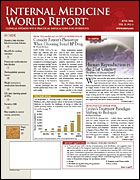Publication
Article
Internal Medicine World Report
Restricting Antibiotics in Animals Reduces Resistance in Humans
Author(s):
But Careful Prescribing of Quinolones Still Necessary
Clinical Infectious Diseases
SEATTLE—Limiting the use of antibiotics in food animals, coupled with careful fluoroquinolone prescribing in clinical settings, can significantly curb food-borne bacterial drug resistance, according to data from a new study published in (2006;42:1368-1374).
Australia’s policy of restricting the use of antibiotics in food-producing animals appears to have lowered levels of drug-resistant bacteria in its citizens, the data show.
Campylobacter jejuni
C jejuni
is a leading bacterial cause of food-borne illness in industrialized countries, and drug resistance to severe infection is a growing concern worldwide, particularly in the United States.
Australia’s response to this problem was to prohibit the use of fluoroquinolones in food animals, such as poultry. This put Australia in the unique position of producing as much animal-derived foods as other industrialized nations, while avoiding the use of antibiotics that have become standard features of food animal production elsewhere.
C jejuni
To evaluate whether Australia’s restrictive antibiotic policy has affected drug resistance, investigators examined isolates collected from 585 patients in 5 Australian states. None of the patients had received fluoroquinolone treatment within the month before becoming ill.
C jejuni
C jejuni
Only 2% of the locally acquired isolates were resistant to ciprofloxacin (Cipro), far below the prevalence that is as high as 29% in countries that allow the use of fluoroquinolones in animals. The investigators note that since ciprofloxacin can be used to treat severe infection, lower levels of drug resistance should translate into greater treatment efficacy.
C jejuni
“There are different causes that lead to bacterial antibiotic resistance, and use of antibiotics in food animals is only one of the multiple causes,” said lead investigator Leanne Unicomb, MD, of the National Centre for Epidemiology and Population Health, Australia National University, Canberra. She added, however, that “use of fluoroquinolones in food animals in other countries has increased the risk of resistance in isolates infecting humans.”
C jejuni
She said other industrialized nations have realized the apparent benefits of restricting antimicrobial use in animals. Sweden prohibited the use of fluoroquinolones for food animals in 1986, and Norway has never allowed them. Both countries have reported low levels of fluoroquinolone-resistant infection in humans.
Taking a cue from the other countries’ successes, the FDA proposed banning the use of fluoroquinolones in poultry in the United States in 2000, but the ban was not enacted until September 2005.
IMWR
“This is an important study, and it irrefutably proves that adding antibiotics to animal feed increases drug resistance and that using less leads to less drug resistance. It is nice to have this proven scientifically,” Edward Septimus, MD, of the University of Texas Medical Center, Houston, told . “This should be of interest to primary care physicians, because they are going to see patients who present with bacterial gastroenteritis; these patients may have eaten contaminated food, and the resistance rates could be around 30%.”
He observed that, “This study shows the resistance rates could be lowered to just about 5% with restricting antibiotic use in food-producing animals.”
KEY POINTS
Restricting the use of antibiotics in animals can reduce antibiotic resistance in humans.
Remember that use of antibiotics in animals is only one of the reasons for resistance.
The FDA-proposed ban on fluoroquinolone use in animals did not take effect until late 2005.
Careful prescribing of fluoroquinolones is still necessary even when they are no longer used in animals.





